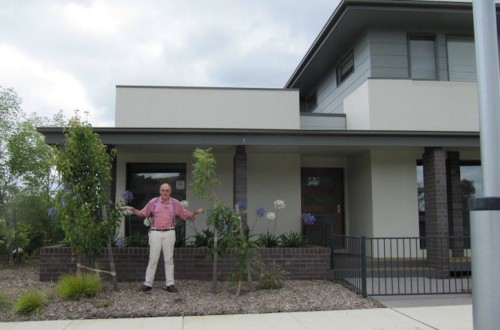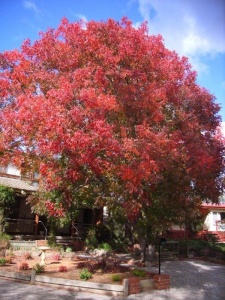ANYONE buying a new home that has been landscaped by the builder and/or developer, beware.
It would appear that trees are often purchased without the builder/developer having any idea of appropriate plants for these gardens, thinking that putting a few random trees and shrubs in constitutes landscaping and will help to sell the home.
Super large trees could cause serious damage to the home in not that many years and roots can damage driveways, paved areas and retaining walls, which can be extremely costly.I am sure tree surgeons don’t mind this, as in a relatively short time they will be removing these troublesome trees.
The real concern is the size of the trees in relation to the block. It is particularly important to select the right trees for the available space, not forgetting underground services, gas, water, sewers etcetera.
Homeowners seek professional advice from a landscape architect/garden designer or even the local garden centre.
Illustrated here is a classic example of a display home with inappropriate trees. I am standing with my outstretched arms just 1.8 metres apart.
On the left is a Liquidambar styraciflua, which can easily grow to 13 metres tall with an 8-metre spread. The other tree is a Pistacia chinensis growing to 10 metres tall and a 6-8-metre spread. And they are both planted just 1.8 metres from the house!To me, this approach to landscaping makes about as much sense as building a home without plans.
If you are unable to identify trees and there is no label, take photos and some leaves to your local garden centre for identification. In many instances, I would be recommending removal before the trees get established. This equally applies if you have purchased an older home with mature trees that may also cause problems.
A NEW hi-resolution map of global forest losses and gains has been created using Google Earth. This is based on 650,000 satellite images and is now publicly available. It charts the world’s tree canopies between 2000 and 2012.
In that time the Earth lost a combined “forest” the size of Mongolia or enough trees to cover the UK six times.More at tinyurl.com/n2srxb9
AFTER recently discussing crabapples, some readers have said parrots love crabapples and, in particular, the red fruit. I understand birds do not touch the yellow fruit of M. “Golden Hornet”.Let me know if this is the case if you are growing this particular crab.
ANYONE intending to plant deciduous shade trees, especially for their autumn leaf colour, should visit a local garden centre now to select the best colours.
Not all trees of the same variety will necessarily have the same leaf colour. For example Acer palmatum, or Japanese maples, are usually grown from seed rather than grafted and the leaf colour will vary considerably. However, if the leaf colour is seen at its best when you buy the tree, it will be the same as it matures.
LOOK for the new Dianthus “Memories” at your local nursery. Its pure-white, long-lasting flowers, exquisite fragrance and low maintenance is perfect for every garden. Join Ita Buttrose and lend your support to Alzheimer’s Australia Dementia Research Foundation with a dollar from the sale of every plant donated by Plant Growers Australia to support the cause.
Jottings…
• Keep fresh animal manure or pelletised chook poo away from emerging leaves of bulbs.
• When potting up containers place a layer of wood charcoal in the bottom of the pot. This acts as drainage and, more importantly, keeps the soil sweet.
• Cut back leaves now of Iris stylosa (winter iris) to allow sunlight into the plant for flower production.
• Be very aware when walking under oak trees. The acorns are very slippery, especially if you have walking difficulties.
The post Gardening: Beware of the big-tree surprise! appeared first on Canberra CityNews.


